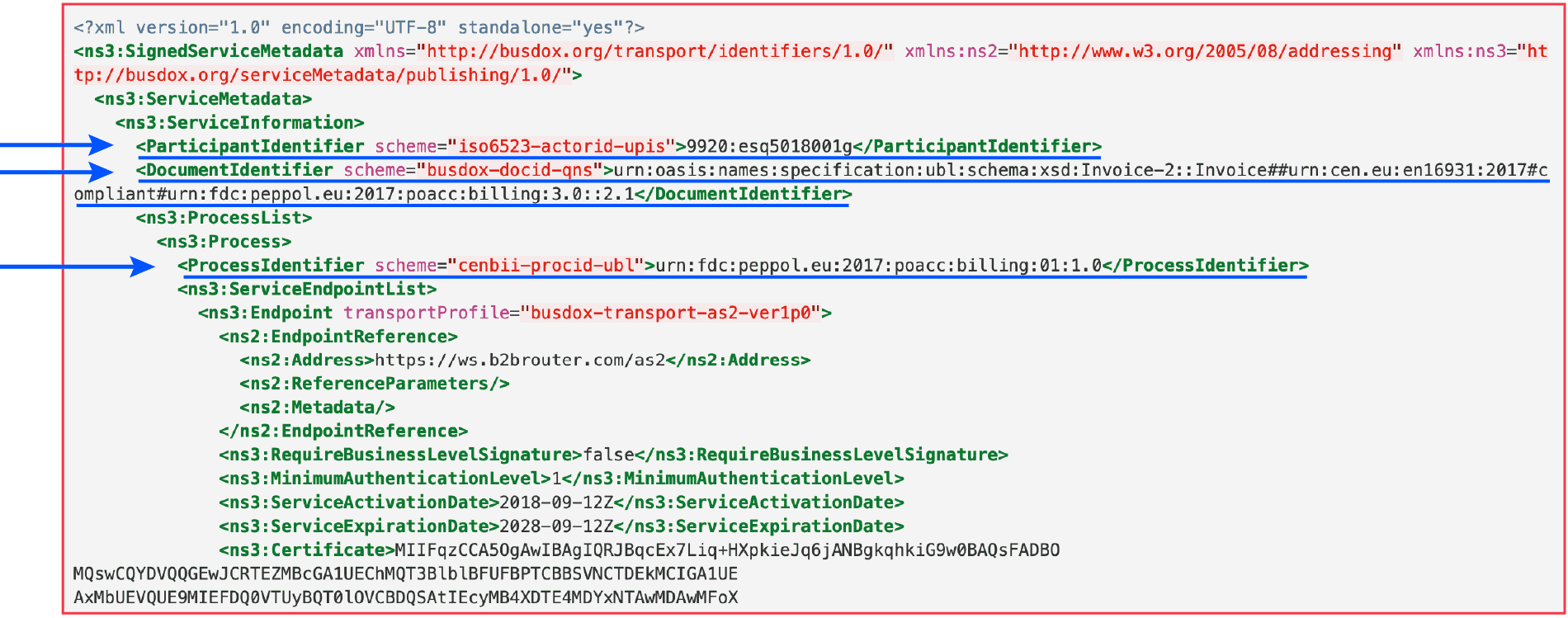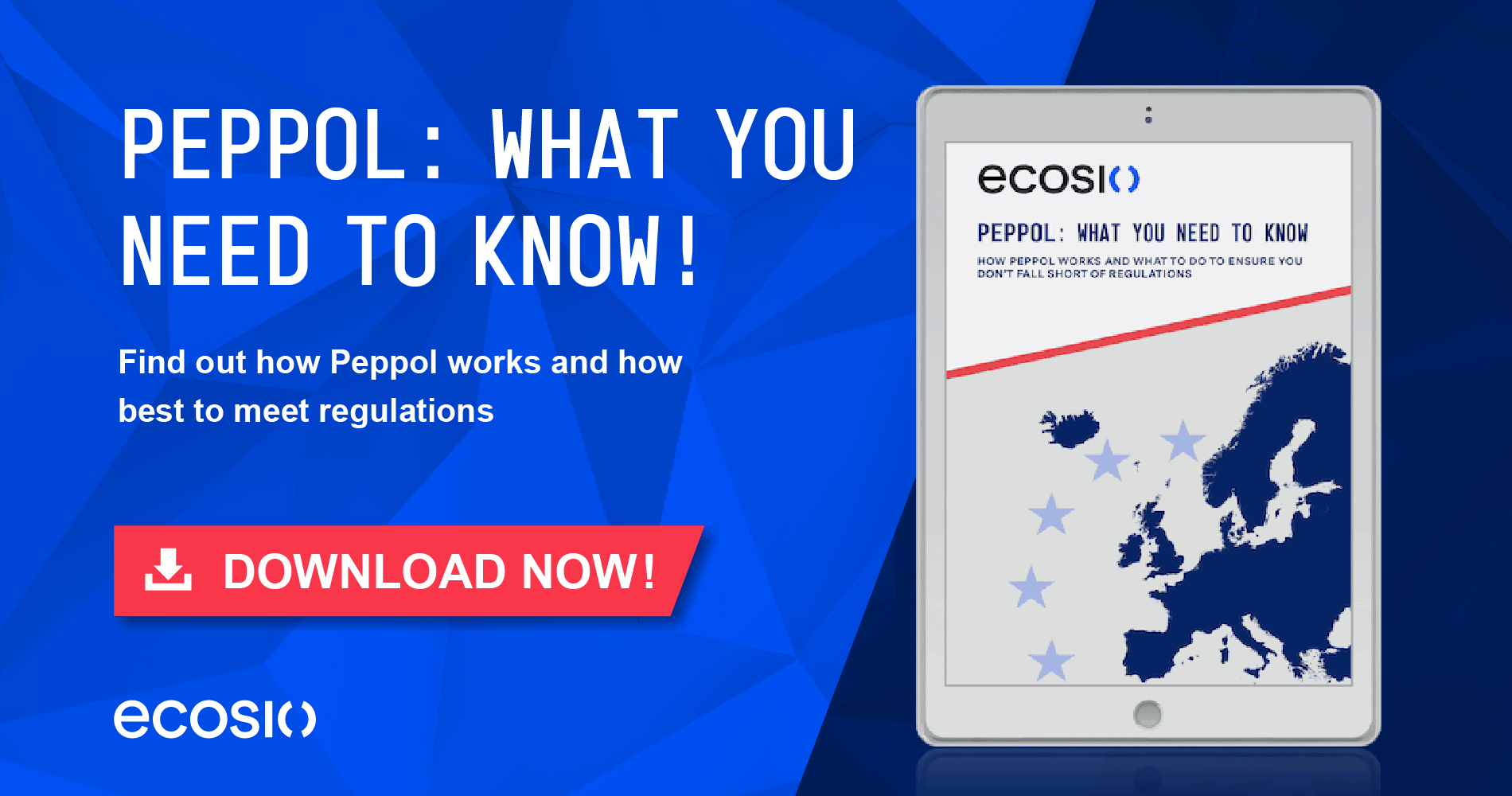Peppol specifications use numerous identifiers to help senders and receivers to establish what is being sent, in what form, and to/from whom. In this article we’ll be focussing on the most important of these – the Peppol Participant Identifier – looking at why it is needed, what it looks like, how to get one and where to find a prospective partner’s Peppol ID.
First, though, it’s important to note that the Peppol ID is only one of several crucial identifiers required for successful document exchange via Peppol…
The three most important identifiers used in Peppol exchanges
The three main identifiers found in messages sent via Peppol are:
- Peppol Participant Identifiers (or Peppol ID)A Peppol Participant Identifier, also known as a Peppol endpoint ID or simply a Peppol ID, is the unique reference that is used to establish the identity of connected parties.
As explored in more detail below, the syntax for a Peppol ID is
<BusDoxParticipantIdentifier>::<IssuingAgencyCode>:<Code>. - Document IdentifiersUnsurprisingly, Document Identifiers are used to indicate which document is being exchanged.
The syntax of Document Identifier is <DocumentIdentifier> = <RootNamespace>::<documentLocalName>##<CustomizationID>::<Version> Within this, <Version> refers to the version of the underlying syntax (i.e UBL 2.1), while Customisation ID specifies the standardised transaction (e.g. invoice) and related Peppol extension. The full syntax of the Customisation ID in turn is <transactionId>:# <extensionId>[#<extensionId>].
- Process IdentifiersProcess identifiers are used to specify what process should be used for the transaction (e.g. invoice only or catalogue only).
The BusDox* Process Identifier scheme used by Peppol is cenbii-procid-ubl. Peppol processes are identified by the respective BII processes and therefore the process identifier must match the BII profile ID. A list of the different Profile IDs can be found in the OpenPeppol eDEC Code List.
Below is an example of a Peppol message, in which it is possible to see where all the above identifiers are located.
Why do I need a Peppol ID?
Every buyer and supplier within the Peppol network must have a Peppol ID. Without a Peppol ID you will be unable to send or receive invoices via the network.
Once you have a Peppol ID your business can exchange automated messages with all other connected companies that support the necessary document types. As discussed in more detail below, a list of the document types that other businesses support can be found via the Peppol directory.
How do I get a Peppol ID?
Peppol IDs are obtained through Peppol Access Point providers. All that is required in order to get an ID is to register with your preferred provider.
What does a Peppol ID look like?
As Peppol doesn’t have its own unique system for identifying connected parties, the network instead employs a federated system based on the ISO 15459 format scheme for unique identifiers. There is a set number of Issuing Agency Codes (IACs) that are acceptable for Peppol compliance. The Peppol ID (or Peppol Party Identifier) you are given will be a combination of the IAC and the value given by the agency issuing the code.
For example, ecosio’s full Peppol ID is iso6523-actorid-upis::0088:9110019474691.
This full endpoint ID is comprised of the BusDox Participant Identifier prefix, the Issuing Agency Code for GS1 (Global Standards 1), and the GLN (Global Location Number), as illustrated below.
What’s needed for Peppol message exchange?
Peppol uses the BusDox infrastructure for message exchange. Within Peppol, BusDox is only concerned with the services that the receiver participant can handle as this is the key information in any exchange. The receiver participant can be a supplier, customer or another business role depending on what is being sent. Significantly, there is also no agreed relationship in Peppol specifications between identifiers used in the document transport infrastructure and in-message identifiers.
When it comes to message exchange in Peppol, BusDox requires the document sender to identify both the receiver participant and the recipient service (this is often their Access Point provider). Generally this is achieved by searching for the relevant Service Metadata Publisher (SMP) in the Service Metadata Locator (SML) to discover the required endpoint address – the endpoint address is the service, or Access Point, address and is different to the endpoint ID used in the document itself. Given this process it is important that the documents and services that the receiver can handle are clearly defined.
In short, every message exchange via Peppol requires the following information:
- The document to be exchanged
- The recipient’s Peppol ID (aka Peppol Participant Identifier)
- The necessary document type ID and process ID
A detailed explanation of how document exchange in Peppol takes place can be found on the website “Peppol Practical – Document exchange explained”. Likewise, a detailed look at the types of message response found in Peppol exchanges can be found in our article “Peppol Message Responses – A Helpful Guide”.
Using the Peppol directory
The Peppol directory is intended to help businesses to identify prospective/existing partners on the network. It can prove particularly useful in the following two scenarios, for example:
- If a business is looking to send invoices via Peppol moving forward and wants to see which of its current trading partners is capable of receiving invoices in the format dictated by Peppol BIS (Business Interoperability Specifications).
- If a business wishes to set up an alert to see when current trading partners join the Peppol network so that future exchanges can take place via Peppol.
Currently anyone is able to search the Peppol directory via this web interface by entering the name, address, ID or any other keyword relating to the entity they want to find. If the business is found, the page will then display key business information (country, entity name, geographical information, website and full Peppol participant ID) in addition to listing all document types supported by the entity.
Planned Peppol directory improvements
Peppol has also outlined the following three improvements that they would like to make in the future. These are:
- Free text search
This functionality would enable the searcher to enter any phrase or list of characters and find all listings that contain that string of text in their Peppol ‘business card’. - Identifier search
This proposed update to the Peppol directory would allow users to search for a business with a certain identifier and specific BIS capabilities. This identifier would not have to be a Peppol ID, however, and could be a VAT or legal identifier. In turn, this would enable businesses to monitor when a specific business gains the ability to send/receive certain documents via Peppol without knowing their Peppol ID. - API search
Rather than having to conduct the search through a separate web interface, users in the future will have the option of accessing the directory via API. This will allow businesses to benefit from automated searches within their existing ERP systems, vastly improving ease of use.
ecosio – your trusted Peppol Access Point provider
ecosio was one of the first certified Peppol Access Points in Europe and is now one of a limited number of Access Point providers that are both AS2 and AS4 compliant.
With a single connection to the ecosio cloud-based EDI solution (our Integration Hub), you will be able to exchange messages with all Peppol-enabled companies.
Want to learn more about Peppol?
For more information on Peppol our white paper “Peppol: What you need to know” can be downloaded at any time.
Alternatively, if you would like advice concerning your specific situation or would like to know exactly what it takes to obtain a Peppol ID and get connected to the network, contact us! We are always happy to answer your questions.
Try our free XML/Peppol document validator!
To help those in need of a simple and easy way to validate formats and file types, from CII (Cross-Industry Invoice) to UBL, we’ve created a free online validator.
* BusDox is a set of specifications designed by OASIS for Peppol document exchange





